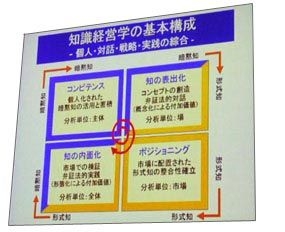A Place Called ba: Rene Descartes and Ikujiro Nonaka Meet, and Nietzsche Joins the Party, Part 3
“Every extension of knowledge arises from making the conscious the unconscious.”
Nietzsche only got part of the formula right. Nonaka postulates that knowledge is really a cycle, moving from conscious to unconscious, and back again. Or rather, from the tacit to the explicit, and back to tacit again.
For those who can read Japanese, here is Nonaka’s grid. For this discussion, you don’t really have to read the words, the colors are the key. Blue is tacit and gold is explicit. As the individual’s knowledge is socialized—i.e., shared with others—the knowledge changes form, from tacit to explicit. As knowledge continues to move through the cycle, from the few to the many, groups of individuals internalize the knowledge, putting it to application. At that moment of application, the knowledge transforms again into tacit form. The application leads to discovery, and the cycle starts again.
Do You Dream? What Are Your Dreams Made Of?
It is said that Edison would write down whatever question he was working on just before he went to bed. As soon as he awoke, he would concentrate on recalling his dreams and find the answer to the question. I don’t know if that is true; it is just a story. But considering what our friend Nietzsche said (quoted at the start of this article), I suspect that there is a grain of truth to it.
We are surrounded by cycles. The seasons are a cycle. There is the notion of a business cycle. The cycle of life. Who taught you how to ride a bicycle? Whom did you teach? Would you call that a cycle?

The diagram above is a simplified form of Nonaka’s grid. Following clockwise from when the problem is encountered and the solution applied:
FIRST: The individual socializes the knowledge, working it into a conscious state until they can share it with others. This socialization takes thought and effort. Consider the study and writing that went into this article, and how I worked through different ways to illustrate these concepts with words and pictures.
SECOND: In externalization we enter the state of ba; you read this article and think about it. In this format, it is a weak form of ba, and we actually do not engage unless you make the effort to comment, to question, to have dialogue with me. The comment sections of some blogs are so active that the conversation becomes loud, too loud for some people to make connections. The same is true for real space, on the telephone, in a bar, a classroom, in a hallway.
As we continue to share the knowledge, to converse about it, we work together to convert it from tacit to explicit. At the moment when you understand the knowledge, when it becomes simple, the knowledge becomes explicit. We collaborate and work to share the knowledge with others, perhaps forming a group, or sharing the knowledge again from individual to individual with the other members of our team, our work group, or our class.
THIRD: In the next stage we combine our voices as a group to share our knowledge with other groups. Again, this exchange can happen in writing, in presentation, or in live settings. Imagine a play in which a group of actors present a story to the audience, from group to group. When done with skill, the actors create a sense of ba from their group to the group that is the audience. A panel discussion at a professional conference is another example. One group presents explicit knowledge to another group, who receive the knowledge in an explicit form.
FOURTH: The last step of the cycle is when the members of the audience of the play or the panel discussion internalize the knowledge. The knowledge is not yet actionable knowledge; not until the receivers think about it, thereby converting it from explicit to tacit. The action in this step is application, where the individual actually puts the knowledge into action and learns whether it works or not. In the application, knowledge returns to tacit, and the individual learns whether the knowledge actually worked to solve the problem.
Think about the last panel discussion you attended. Why did you go? Were the people on the panel knowledgeable about the topic? Did you learn anything?
Nonaka would say that you did not learn a thing until you put the idea to application.


